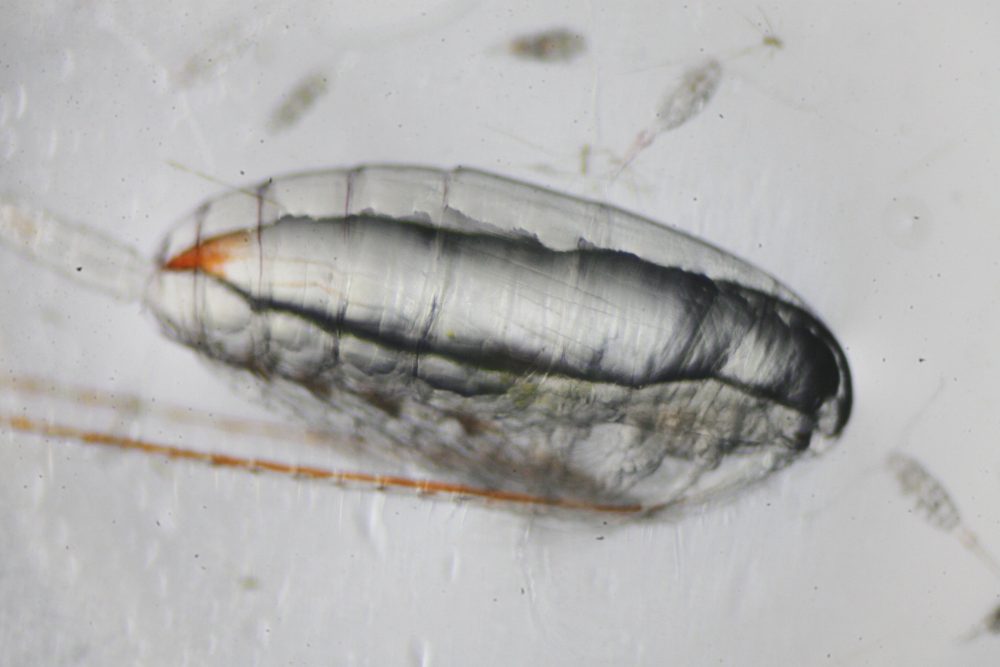Copepod Physiology
Calanoid copepods are among Earth’s most abundant animals, and they play a key role in moving energy from the base of the food chain to higher consumers. Some copepods, such as Calanus finmarchicus, can undergo a dormant period (diapause) during their juvenile development. It is not well understood how copepods “decide” whether to undergo diapause, or when to enter or exit diapause. Work in our lab focuses on understanding how the physiological condition of lipid-storing copepods changes in relation to their environment, how diapause helps copepods to adapt to their environment, and how copepod populations may respond to future environmental change.
Some current areas of focus:
Metabolic adaptations of Antarctic Copepods
Antarctic copepods have developed particular feeding and behavioral strategies to survive in their very seasonal environment, it is not known how each of these species will respond to environmental change. The overall goal of this project is to examine and compare these adaptations across species and to understand how each species responds to short-term changes in food availability. The project contains three main objectives: the first objective is to compare the sets of genes across species, especially looking at genes related to storage of energy from food. The second objective is to measure and compare the responses of copepods to changes in food availability. The third objective is to determine how variation across the western Antarctic Pensinsula habitat affects the feeding condition of the copepods. Field work for this project was conducted through a collaboration with an existing sampling program (the Palmer Long-Term Ecological Research Regional Grid). I wrote many blog posts about the field work and a few about the subsequent analysis (all "rolled up" here: Antarctic_blog).
Our first paper has been published (paper here, blog post describing it here, including the transcriptome of the copepod Rhincalanus gigas and changes in gene expression during development from the juvenile to adult female stage. We are hoping to publish the rest of our results soon! This project has been funded by the Office of Polar Programs at NSF.
Circadian metabolic rhythms in migratory zooplankton
This project (led by Dr. Amy Maas at BIOS) focuses primarily on the migratory copepod Pleuromamma xiphias. We are using a suite of techniques (respirometry, proteomics, transcriptomics, enzyme activity assays) to study how the physiology of these animals changes over daily cycles and in relationship to diel vertical migration. As these small animals move into deeper water each day, they continue to respire, excrete, and sometimes they even die and may sink into deep waters. We know in general that metabolic rates vary over daily cycles, but it’s not clear how these cycles interact with the temperature changes and activity bursts that the copepods experience while migrating. Measuring these processes is important to understanding how migratory zooplankton contribute to the vertical movement of nutrients and carbon through the water column. We sampled P. xiphia over the course of it's daily migration and measured fecal pellet production, rates of respiration and enzymatic activity, gene expression and protein abundance.
We have found that the copepods continue to produce fecal pellets after they migrate into deep water, which provides direct evidence of active flux of particulate organic carbon (paper here, related blog post here). We’ve also found that the activities of metabolic enzymes vary during diel vertical migration, with a surprising finding of high rates of the electron transport system (ETS) during the afternoon (contrary to our prediction of reduced daytime metabolism). Together the observations of fecal pellet production and high ETS activity during the day, suggests that the copepods may be more active than previously believed after migration to depth. A manuscript describing the transcriptional patterns is currently in revision. This project has been funded by the Biological Oceanography Program at NSF.
Other recent(ish) results:
- During a Fall 2015 cruise in the Bering Sea aboard the NOAA Ship Oscar Dyson. We sampled Calanus copepodids and conducted experiments to identify molecular and physiological signatures of food deprivation. Overall, we found large spatial variation in temperature, chlorophyll concentration, and copepod abundance, but surprisingly little variation in copepod lipid stores or the expression of lipid storage genes. This suggests that Calanus throughout the sampled region had experienced favorable growth conditions. We also found that the Calanus community was overwhelmingly composed of Calanus glacialis, with only a few Calanus marshallae individual and no latitudinal trend in Calanus species composition within the study region. Link to a blog post describing this work. and the publication (Tarrant et al. 2021 Mar Ecol Prog Ser). This work was funded by the WHOI Access to the Sea Program.
- Oh diapause....still so mysterious! Predation risk is considered a major ultimate driver of copepod diapause behavior, but can chemical cues from predators act as a trigger for Calanus diapause? A study led by Kristina Kvile found that exposing Calanus finmarchicus to chemical cues from a predatory fish led to faster copepod development but did not stimulate diapause in the lab. Related collaborative work led by Elise Skottene found that exposure of copepods to predators increased the expression of lipid catabolic genes when food was abundant and appeared to disrupt lipid accumulation when food was scarce. Together these studies indicate that exposure to predator chemical cues can modulate copepod life history but does not appear to directly stimulate diapause. So how can we trigger diapause in the lab?? I have ideas....stay tuned.
